New Marginal Spectrum Feature Information Views of Humpback Whale Vocalization Signals Using the EMD Analysis Methods
Abstract
:1. Introduction
1.1. The Related References
1.2. The Related EMD-Based MS Analysis Method [9]
2. Humpback Whale Vocalizations
3. Analysis Results
3.1. Class I HWV Samples
3.2. Class II HWV Samples
3.3. Class III HWV Samples
4. Discussion
5. Conclusions
Author Contributions
Funding
Institutional Review Board Statement
Informed Consent Statement
Data Availability Statement
Conflicts of Interest
Abbreviations
| BBW | Blainville’s beaked whales |
| BFW | blue and fin whales |
| BMSWV | bull male sperm whale vocalizations |
| BOWV | Balaenoptera omurai whale vocalizations |
| BW | blue whale |
| DP | distinctive peak |
| DSCV | down-swept contour vocalizations |
| ES | echolocation signals |
| EMD | empirical mode decomposition |
| FMTUC | frequency-modulated tonal up-chirp |
| HHT | Hilbert–Huang transformation |
| HT | Hilbert transform |
| HW | humpback whale |
| HWV | humpback whale vocalization |
| IMF | intrinsic mode function |
| IF | instantaneous frequency |
| KW | killer whales |
| LFS | low-frequency sounds |
| MS | marginal spectrum |
| PAMS | passive acoustic monitoring system |
| RF | residual function |
| R-type | resident-type |
| SW | sperm whale |
| TF | time–frequency |
References
- Huang, N.E.; Shen, Z.; Long, S.R.; Wu, M.C.; Shih, H.H.; Zheng, Q. The empirical mode decomposition and the Hilbert transform spectrum for nonlinear and non-stationary time series analysis. Proc. R. Soc. A 1998, 454, 903–995. [Google Scholar] [CrossRef]
- Huang, N.E.; Shen, S.S.P. Hilbert-Huang Transform and Its Applications; World Scientific Publishing Co., Pte. Ltd.: Singapore, 2014. [Google Scholar]
- Yan, R.; Gao, R.X. A tool of the Hilbert-Huang Transform: An empirical tool for signal analysis. IEEE Instrum. Meas. Mag. 2007, 10, 40–45. [Google Scholar] [CrossRef]
- Kizher, S.; Flatley, T.P.; Huang, N.E.; Smith, D. On the Hilbert-Huang transform data processing system development. In Proceedings of the 2004 IEEE Aerospace Conference Proceedings (IEEE Cat. No. 04TH8720), Big Sky, MT, USA, 6–13 March 2004; pp. 1–19. [Google Scholar]
- Huang, N.E.; Shen, Z.; Long, S.R. A new view of nonlinear water waves: The hilbert spectrum. Annu. Rev. Fluid Mech. 1999, 31, 417–457. [Google Scholar] [CrossRef]
- Adam, O. Advantages of Hilbert Huang transform for marine mammals signals analysis. J. Acoust. Soc. Am. 2006, 120, 2965–2973. [Google Scholar] [CrossRef] [PubMed]
- Adam, O. The use of the Hilbert-Huang transform to analyze transient signals emitted by sperm whales. Appl. Acoust. 2006, 67, 1134–1143. [Google Scholar] [CrossRef]
- Adam, O. Segmentation of Killer Whale Vocalizations Using the Hilbert-Huang Transform. EURASIP J. Adv. Signal Processing 2008, 67, 1–11. [Google Scholar] [CrossRef]
- Lin, C.F.; Chung, Y.C.; Zhu, J.D.; Chang, S.H.; Wen, C.C.; Parinov, I.A.; Shevtsov, S.N. The energy based characteristics of sperm whale clicks using the Hilbert Hunag transform analysis method. J. Acoust. Soc. Am. 2017, 142, 504–511. [Google Scholar] [CrossRef]
- Wen, C.S.; Lin, C.F.; Chang, S.H. Extraction of energy characteristic of blue whale vocalization base on empirical mode decomposition. Sensors 2022, 22, 2737. [Google Scholar] [CrossRef]
- Wen, C.S.; Lin, C.F.; Chang, S.H. EMD-Based Energy Spectrum Entropy Distribution Signal Detection Methods for Marine Mammal Vocalizations. Sensors 2023, 23, 5416. [Google Scholar] [CrossRef]
- Whitlow, W.L.A.; Marc, O.L. Listening in the Ocean: New Discoveries and Insights on Marine Life from Autonomous Passive Acoustic Recorders; Springer: New York, NY, USA, 2016; pp. 1–415. [Google Scholar]
- Goold, J.C.; Jones, S.E. Time and frequency domain characteristics of sperm whale clicks. J. Acoust. Soc. Am. 1995, 98, 1279–1291. [Google Scholar] [CrossRef]
- Keating, J.L.; Barlow, J.; Rankin, S. Shifts in frequency-modulated pulses recorded during an encounter with Blainville’s beaked whales (Mesoplodon densirostris). J. Acoust. Soc. Am. 2016, 140, EL166–EL171. [Google Scholar] [CrossRef] [PubMed]
- Houser, D.S.; Mulsow, J.; Almunia, J.; Finneran, J.J. Frequency-modulated up-chirp stimuli enhance the auditory brainstem response of the killer whale (Orcinus orca). J. Acoust. Soc. Am. 2019, 146, 289–296. [Google Scholar] [CrossRef]
- Madhusudhana, S.; Murray, A.; Erbe, C. Automatic detectors for low-frequency vocalizations of Omura’s whales, Balaenoptera omurai: A performance comparison. J. Acoust. Soc. Am. 2020, 147, 3078–3090. [Google Scholar] [CrossRef]
- Filatova, O.A. Independent acoustic variation of the higherand lower-frequency components of biphonic calls can facilitate call recognition and social affiliation in killer whales. PLoS ONE 2020, 15, e0236749. [Google Scholar] [CrossRef]
- Reyes, M.v.R.; Pickering, S.B.; Simonis, A.; Melcón, M.L.; Trickey, A.; Hildebrand, J.; Iñíguez, M. High-Frequency Modulated Signals Recorded Off the Antarctic Peninsula Area: Are Killer Whales Emitting Them? Acoust Aust. 2017, 45, 253–260. [Google Scholar] [CrossRef]
- Malige, F.; Patris, J.; Buchan, S.J.; Stafford, K.M.; Shabangu, F.; Findlay, K.; Gaete, R.H.; Neira, S.; Clark, C.W.; Glotin, H. Inter-annual decrease in pulse rate and peak frequency of Southeast Pacific blue whale song types. Sci. Rep. 2020, 10, 8121. [Google Scholar] [CrossRef] [PubMed]
- Frazer, L.N.; Mercado, E. A sonar model for humpback whale song. IEEE J. Ocean. Eng. 2000, 25, 160–182. [Google Scholar] [CrossRef]
- Au, W.W.L.; Pack, A.A.; Lammers, M.O.; Herman, L.M.; Deakos, M.H.; Andrews, K. Acoustic properties of humpback whale songs. J. Acoust. Soc. Am. 2006, 120, 1103–1110. [Google Scholar] [CrossRef]
- Kugler, A.; Lammers, M.O.; Zang, E.J.; Kaplan, M.K.; Mooney, T.A. Fluctuations in Hawaii’s humpback whale Megaptera novaeangliae population inferred from male song chorusing off Maui. Endanger. Species Res. 2020, 43, 421–434. [Google Scholar] [CrossRef]
- Mercado, E.; Herman, L.M.; Pack, A.A. Song copying by humpback whales: Themes and variations. Anim. Cogn. 2005, 8, 93–102. [Google Scholar] [CrossRef]
- Bilal, M.; Songzuo, S.; Qiao, G.; Wan, L.; Tao, Y. Bionic Morse Coding Mimicking Humpback Whale Song for Covert Underwater Communication. Appl. Sci. 2020, 10, 186. [Google Scholar] [CrossRef]
- Angela, R.S.; Christine, E.; Chandra, S.K.; Miles, P. Non-song Vocalizations of Humpback Whales in Western Australia. Front. Mar. Sci. 2020, 7, 141. [Google Scholar]
- Zhang, W.; Sun, H.H.; Zhang, Q.; Zhang, P.; Li, C. SSTNet: Spatial, spectral, and texture aware attention network using hyperspectral image for corn variety identification. IEEE Geosci. Remote Sens. Lett. 2022, 19, 5514205. [Google Scholar] [CrossRef]
- Watkins Marine Mammal Sound Database. Available online: https://cis.whoi.edu/science/B/whalesounds/index.cfm (accessed on 10 August 2023).
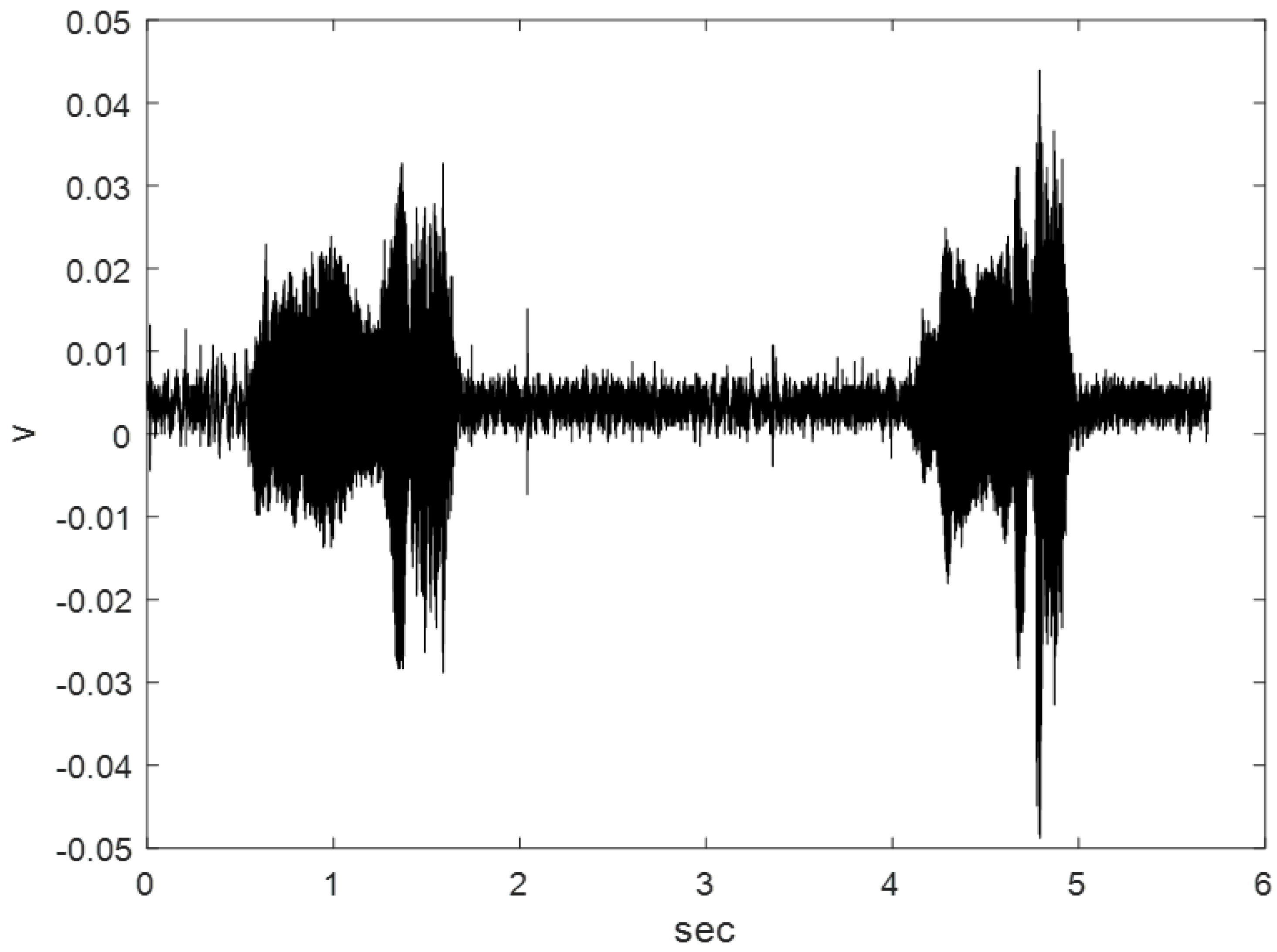

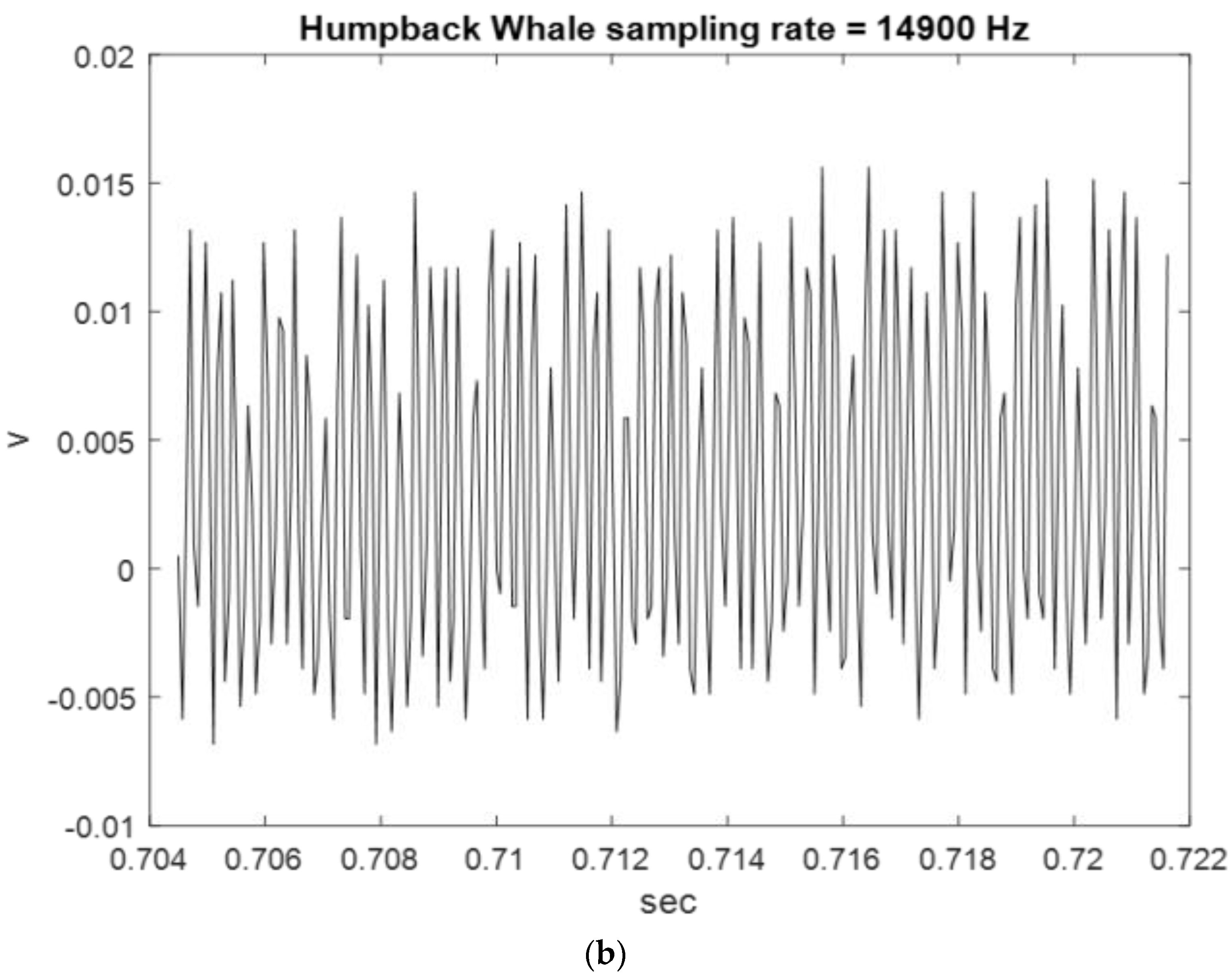
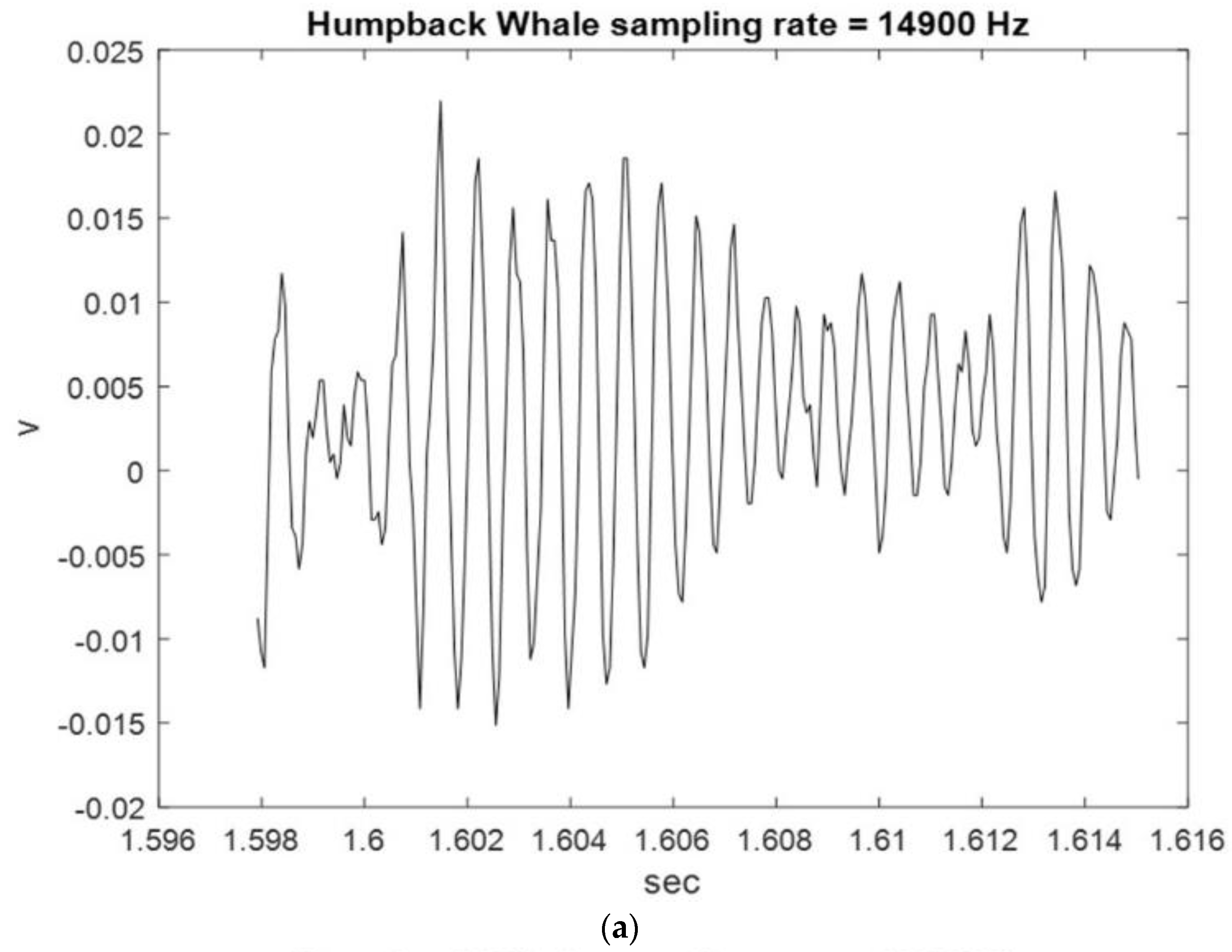


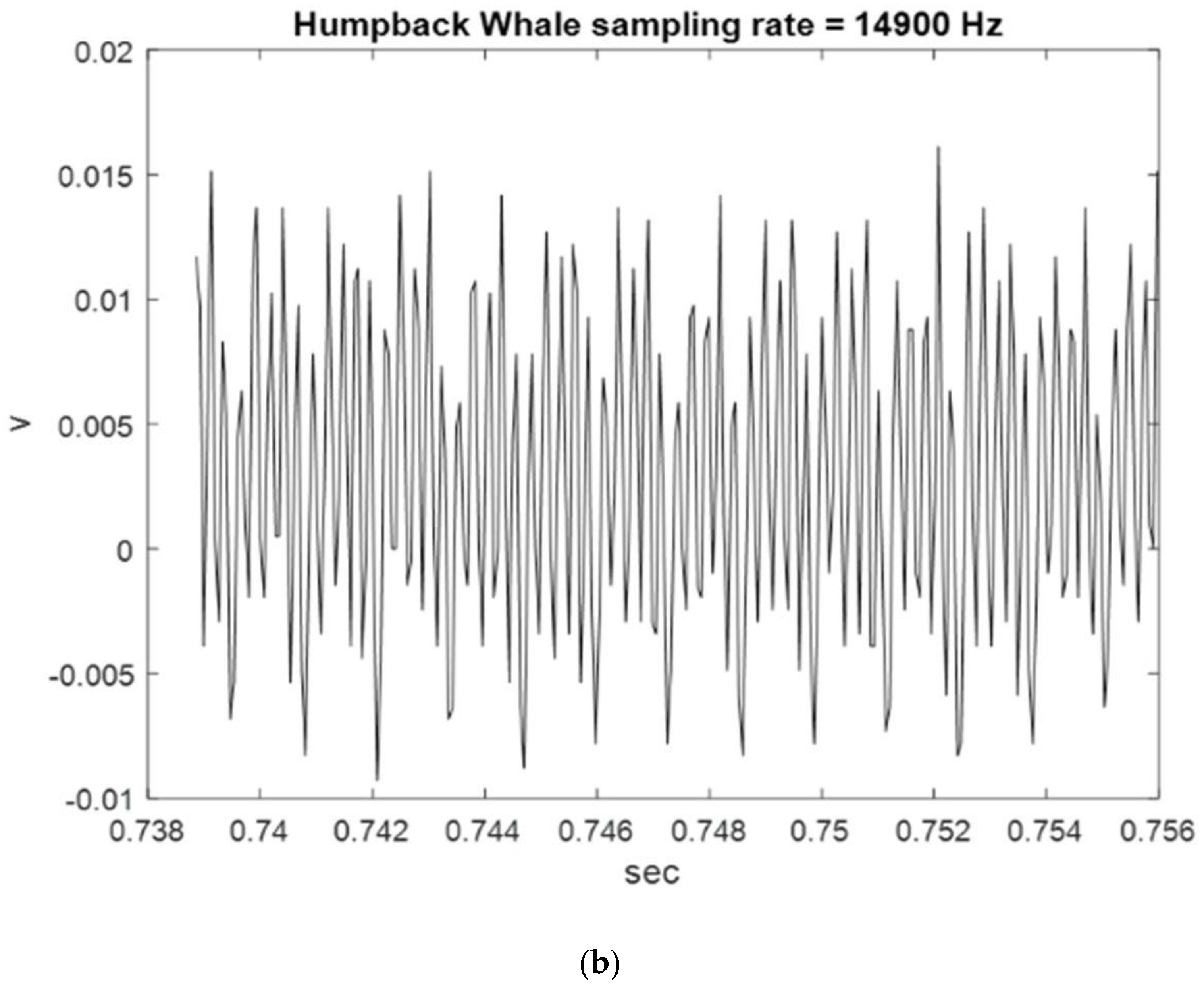
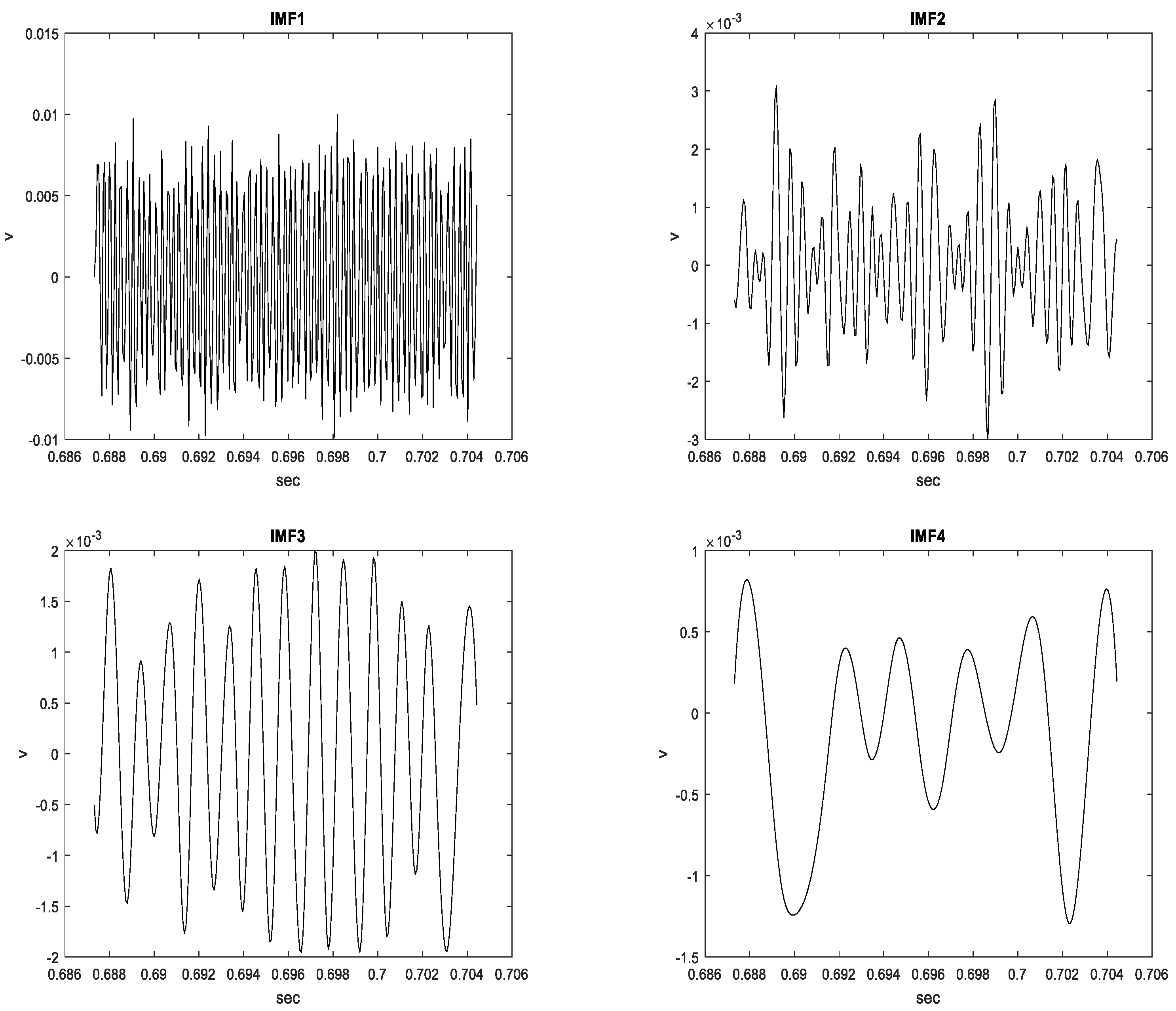


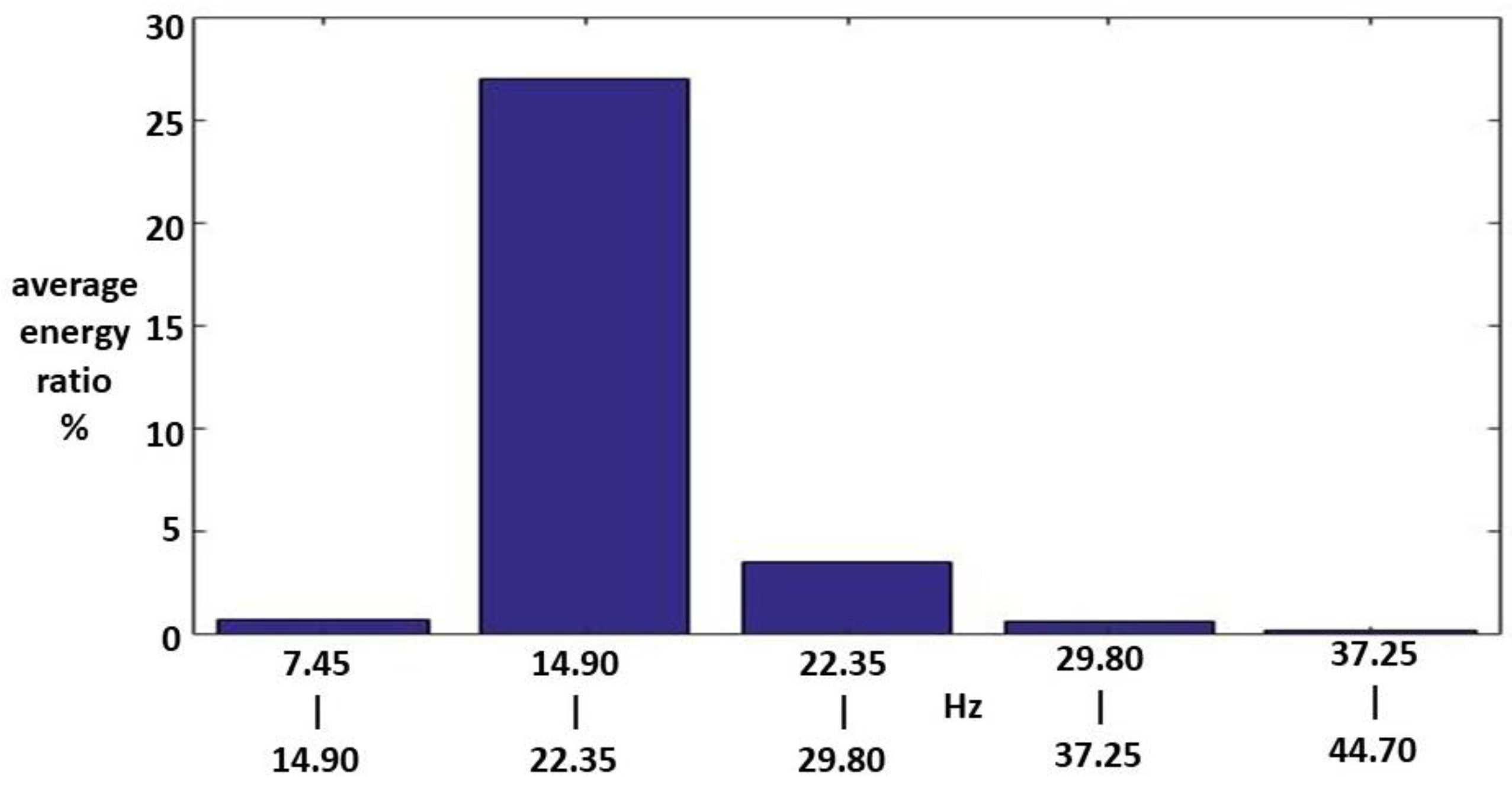
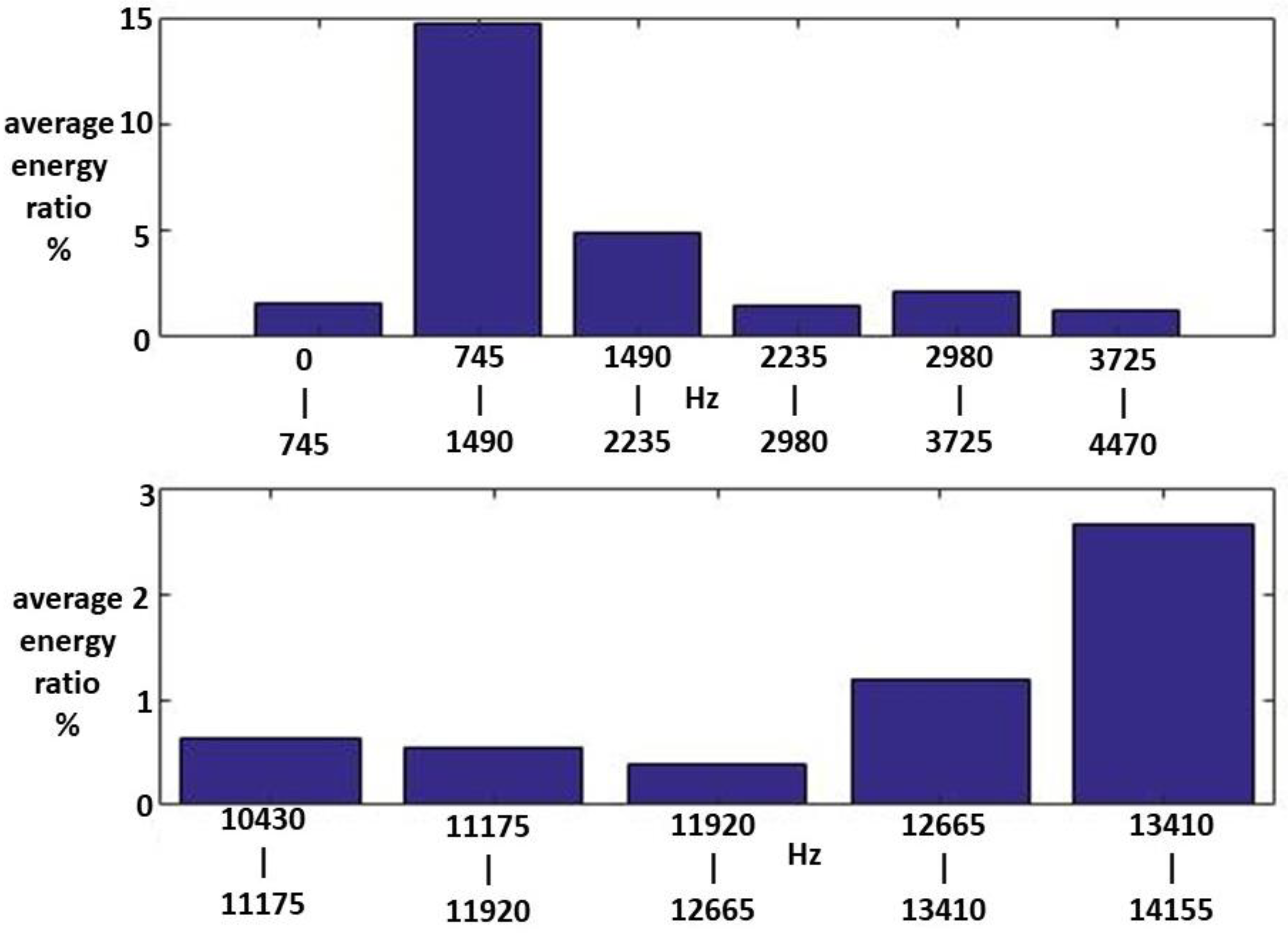
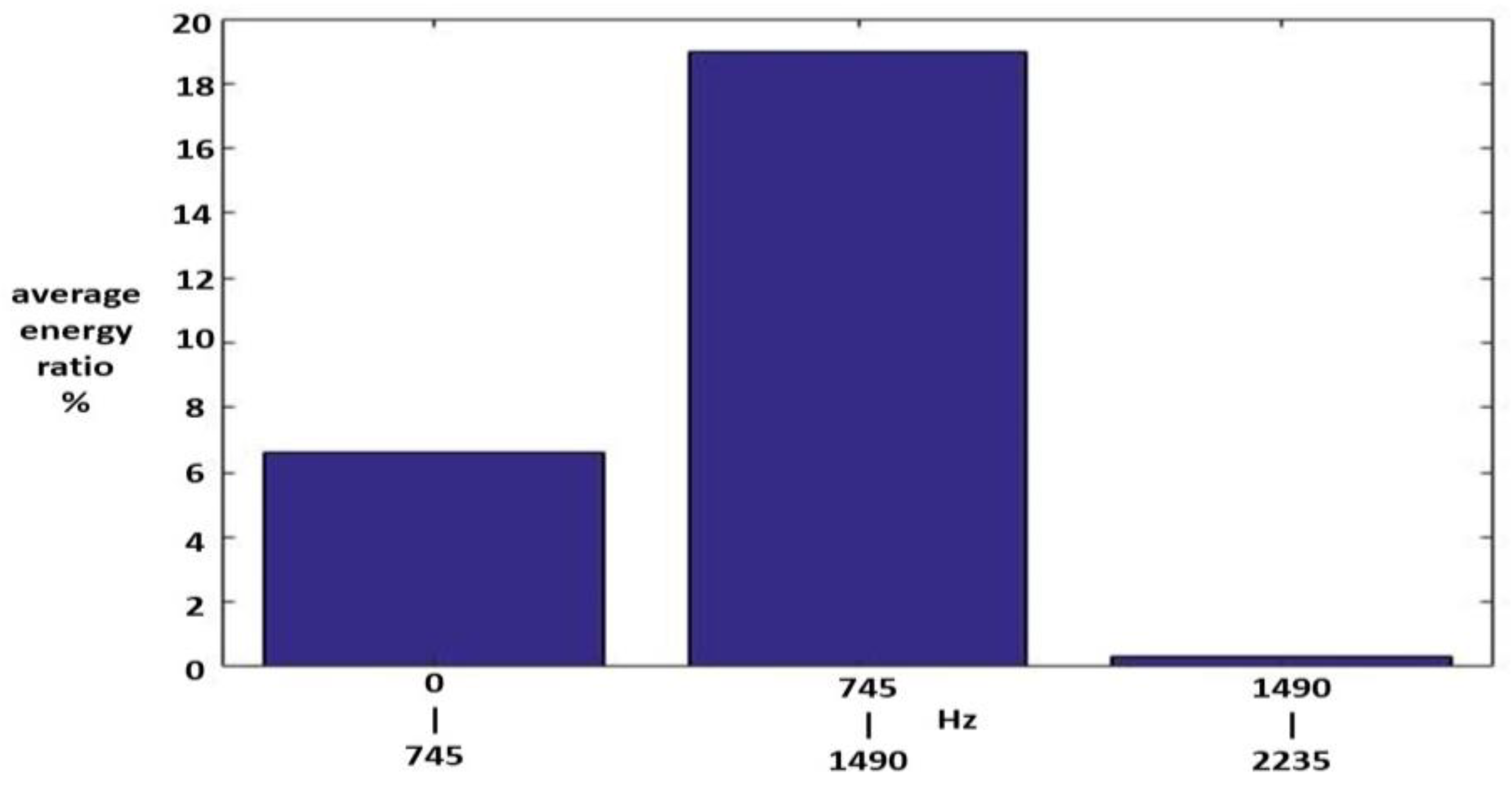

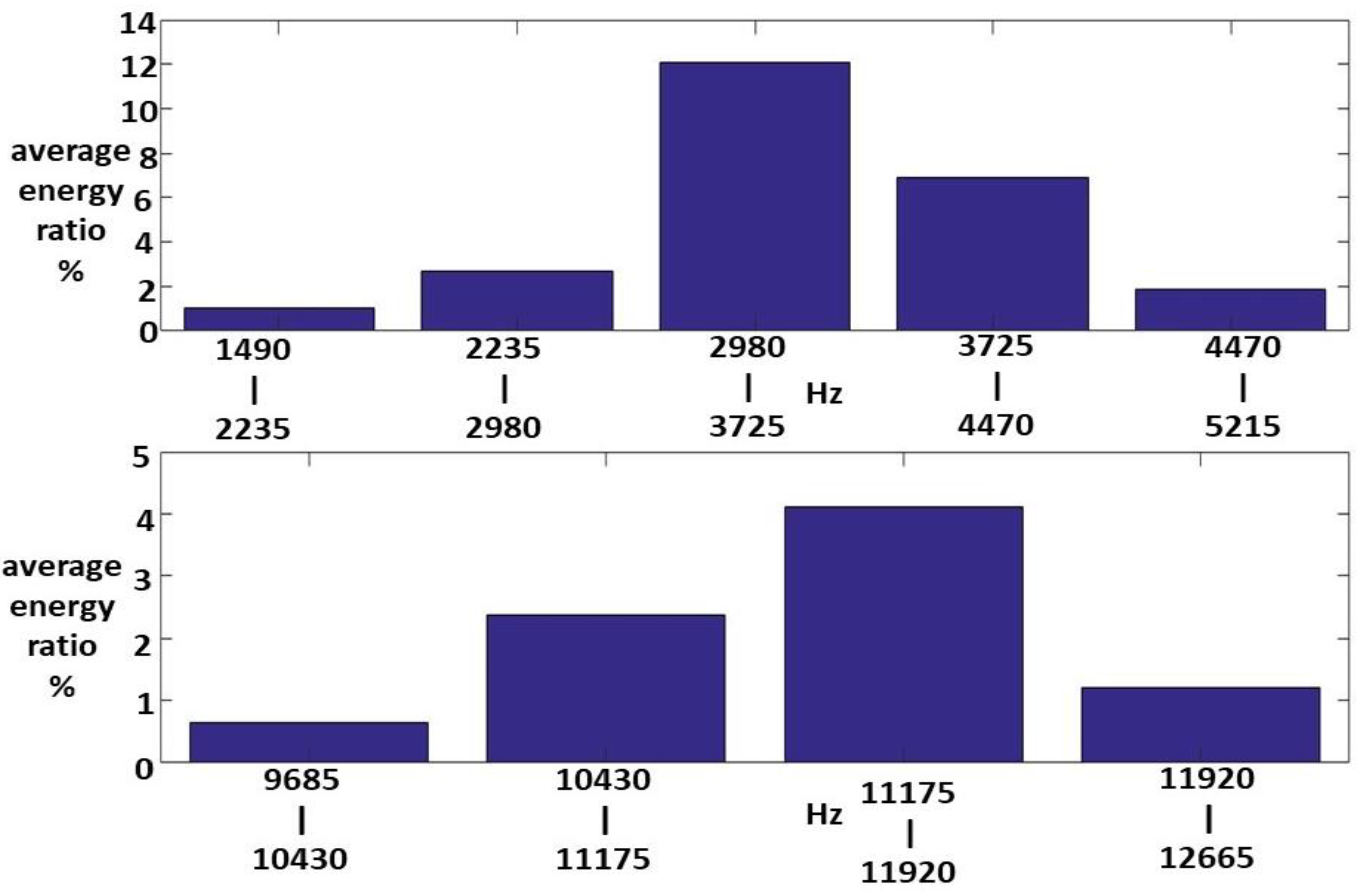



| (a) | |||||
|---|---|---|---|---|---|
| Whitlow et al. [12] | Goold et al. [13] | Keating et al. [14] | Houser et al. [15] | Madhusudhana et al. [16] | |
| Whale species | BFW LFS | BMSWV DP | BBW ES | KW FMTUC | BOWV |
| Analysis method | PAMS | Fourier | Fourier | Fourier | Fourier |
| Important band | 10–20 Hz | 400–2000 Hz | Center frequency 39.5 kH 10 dB bandwidth 9.3 kHz | 10–130 kHz | 15–62 Hz |
| (b) | |||||
| Reyes et al. [18] | Malige et al. [19] | Frazer et al. [20] | Au et al. [21] | Kugler et al. [22] | |
| Whale species | KW DSCV | BW song | HWV | HWV | HWV |
| Analysis method | Fourier | Fourier | Fourier | Fourier | Fourier |
| Important band | 15.7–21.6 kHz 10 dB bandwidth 5.9 kHz | Peak frequency 32 Hz | >21 kHz | 0–1500 Hz | |
| (c) | |||||
| Mercado et al. [23] | Bilal et al. [24] | Angela et al. [25] | |||
| Whale species | HWV | HWV song | HWV Non-song | ||
| Analysis method | Fourier | Fourier | Fourier | ||
| Important band | <400 Hz 3–8 kHz | Hz | 9–6000 Hz | ||
| (a) | ||||
|---|---|---|---|---|
| Proposed Features Class I | Proposed Features Class II | Proposed Features Class III | Lin et al. [9] Click I | |
| Whale species | HWV | HWV | HWV | SW |
| Analysis sample duration | 17.2 ms | 17.2 ms | 17.2 ms | 10 ms |
| Number of IMFs | 6 | 6 | 6 | 7 |
| Important IMFs | IMF1 (46.37%) | IMF1 (32.06%) IMF2 (29.22%) | IMF1 (34.29%) IMF6 (15.80%) | IMF1 (61.50%) IMF2 (12.41%) |
| Important RF | 34.21% | 22.64% | 38.33% | - |
| MS1 | 2980–3725 Hz (9.825%) 3725–4470 Hz (13.79%) | 745–1490 Hz (14.675%) | 2980–3725 Hz (12.064%) 3725–4470 Hz (6.885%) | 11–15 kHz (30.05%) |
| MS2 | - | 745–1490 Hz (18.990%) | - | 4–5 kHz (1.20%) 6–7 kHz (1.04%) |
| MS3 | - | - | - | - |
| MS4 | - | - | - | - |
| MS6 | - | - | 52.15–59.60 Hz (10.237%) | - |
| MS RF | 14.9–22.35 Hz (26.987%) | 14.9–22.35 Hz (21.633%) | 14.9–22.35 Hz (32.828%) | - |
| Application | Features extraction | Features extraction | Features extraction | Features extraction |
| (b) | ||||
| Lin et al. [9] Click II | Wen et al. [10] Class I | Wen et al. [10] Class II | Adam [6] | |
| Whale species | SW | BWBCV | BWBCV | KW |
| Analysis sample duration | 5 ms | 180 ms | 180 ms | 650 ms |
| Number of IMFs | 6 | 5 | 5 | 13 |
| Important IMFs | IMF1 (73.33%) IMF2 (13.89%) | IMF1 (83.40%) | IMF1 (32.63%) IMF2 (37.00%) IMF3 (11.95%) IMF4 (12.07%) | - |
| Important RF | - | - | - | - |
| MS1 | - | 34–52 Hz (74.18%) | 41–52 Hz (24.08%) | - |
| MS2 | 8–15 kHz (46.94%) | - | 10–18 Hz (28.29%) | - |
| MS3 | 3–7 kHz (10.08%) | - | 4–7 Hz (10.38%) | - |
| MS4 | - | - | 5–6 Hz (11.36%) | - |
| MS6 | - | - | - | - |
| MS RF | 0–1 kHz (7.83%) | - | - | - |
| Application | Features extraction | Features extraction | Features extraction | Denoise and Features extraction |
Disclaimer/Publisher’s Note: The statements, opinions and data contained in all publications are solely those of the individual author(s) and contributor(s) and not of MDPI and/or the editor(s). MDPI and/or the editor(s) disclaim responsibility for any injury to people or property resulting from any ideas, methods, instructions or products referred to in the content. |
© 2023 by the authors. Licensee MDPI, Basel, Switzerland. This article is an open access article distributed under the terms and conditions of the Creative Commons Attribution (CC BY) license (https://creativecommons.org/licenses/by/4.0/).
Share and Cite
Lin, C.-F.; Wu, B.-R.; Chang, S.-H.; Parinov, I.A.; Shevtsov, S. New Marginal Spectrum Feature Information Views of Humpback Whale Vocalization Signals Using the EMD Analysis Methods. Sensors 2023, 23, 7228. https://doi.org/10.3390/s23167228
Lin C-F, Wu B-R, Chang S-H, Parinov IA, Shevtsov S. New Marginal Spectrum Feature Information Views of Humpback Whale Vocalization Signals Using the EMD Analysis Methods. Sensors. 2023; 23(16):7228. https://doi.org/10.3390/s23167228
Chicago/Turabian StyleLin, Chin-Feng, Bing-Run Wu, Shun-Hsyung Chang, Ivan A. Parinov, and Sergey Shevtsov. 2023. "New Marginal Spectrum Feature Information Views of Humpback Whale Vocalization Signals Using the EMD Analysis Methods" Sensors 23, no. 16: 7228. https://doi.org/10.3390/s23167228
APA StyleLin, C.-F., Wu, B.-R., Chang, S.-H., Parinov, I. A., & Shevtsov, S. (2023). New Marginal Spectrum Feature Information Views of Humpback Whale Vocalization Signals Using the EMD Analysis Methods. Sensors, 23(16), 7228. https://doi.org/10.3390/s23167228







